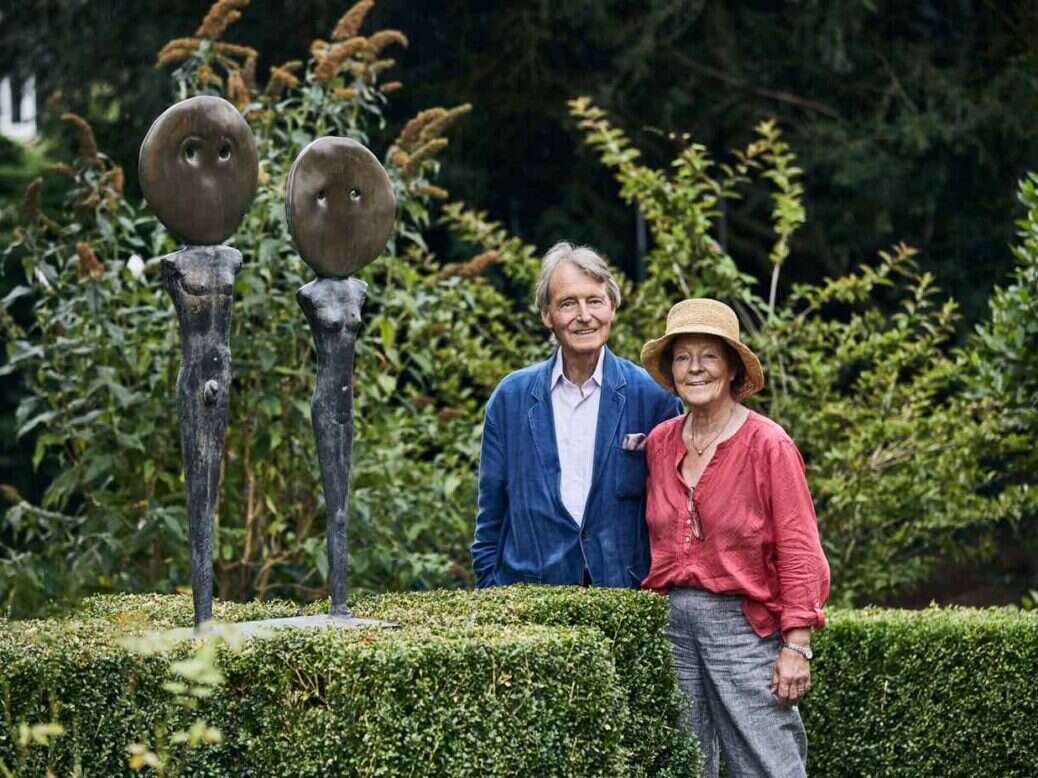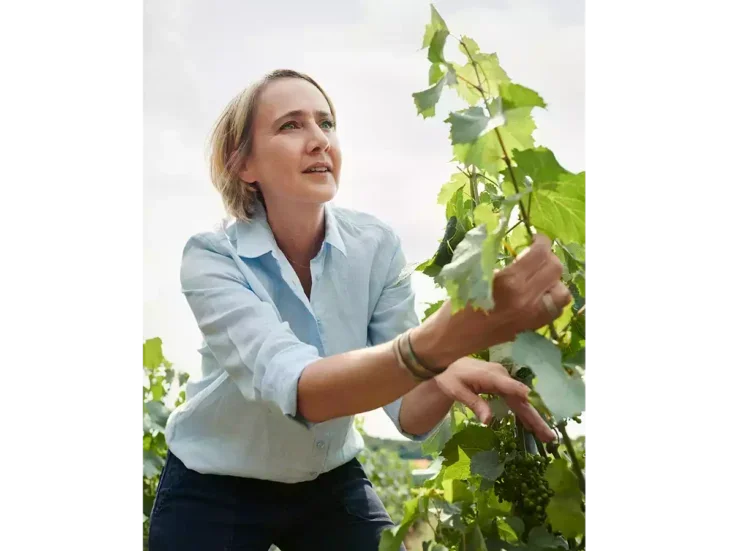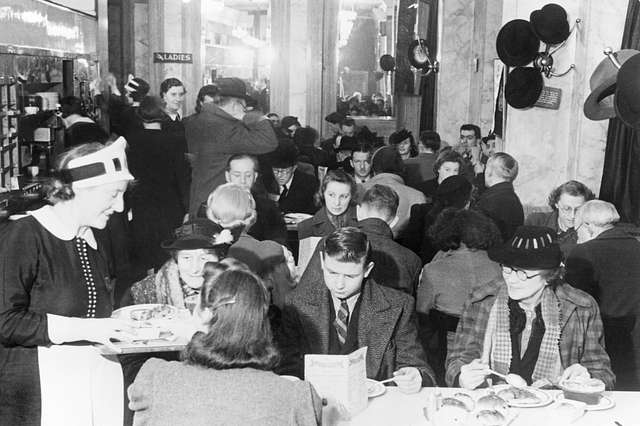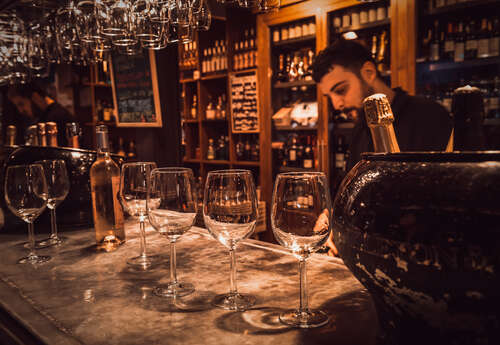
Hugh Johnson celebrates the remarkable life and achievements of the wine writer, winemaker, businessman, and art collector, Steven Spurrier (1941 to 2021).
It should be simple to write about Steven, as a recent and treasured memory, and with his detailed and vivid autobiography recently republished and open beside me. The facts are all here, and I’ll try to summarize them, pretty eye-watering as they are, but of course they only tell his side of the story. Steven lived life in the fast lane. But the facts could give a false impression: whizz-kid he was not; more the gentleman explorer, dinner-jacket in the jungle.
There is no denying he was born with a silver spoon in his mouth—or at least his reach. (What an old-fashioned expression; does anyone still polish silver?) The Derbyshire estate where he was brought up was not what he wanted—which was always the bright lights, the linen napkins. So, Rugby School was not his ideal, either; he found it neither fast nor bright. For Steven the grass was always greener on the other side of the hill. So, he climbed the hill and explored the reverse slope.
Is there one word that points the way he pointed? Positive? Optimistic? Gung-ho? The picture of a rumbustious, noisy, leader-from-the front is not right. Your first impression of Steven was of someone tentative: a little nervous, with a slight stammer to drive home the point. That element of reserve never left him, and perhaps made him all the more persuasive in the various projects and ideas he was keen for you to believe in. Overflowing enthusiasm is infectious, too. But behind it all was quite simply a flood of new ideas, many of them too good, so by definition ahead of their time.
By his account the die was cast when he was a mere boy. It was the Cockburn ’08 with grandpa that did it. We all believe our own myths; this was as good as they get. After the usual fumbling (he was tempted by dealing in art and antiques, and collected art all his life), the primrose path opened before him. He not only saw the wine trade as his route to happiness, he was game to go through its often quite grisly rites of initiation. Bottle-washing, forelock-touching—that kind of thing. One of London’s oldest wine merchants, Christophers in St James’s, afforded him opportunities for both, and he latched on to every chance to travel and learn.
He played his ace card here, shrewdly and early. He wanted the experiences of an intern but he was determined to keep his freedom. So, he said “Don’t pay me”—and it shifted his relationship with the grands fromages of the companies he worked for (it’s tempting, already, to say “with”) from skivvy, to au pair.
It was not until I read his memoirs that I discovered how closely parallel his wine apprenticeship was with my own, at least in timing. I was two years “above” him at school, but my three years at university somehow brought us level, so that we both did our exploratory tours of the wine world (or at least its European part) in the same forlorn vintage, 1965. It rained non-stop wherever we went. Steven was employed, entertained, migrating from château to château. I was driving round much the same circuit in my new wife’s little red Mini. But what days those were.
How we never met I don’t know, except that he was on the inside of the wine trade, I was on the outside, looking in. All the characters, the names he could tell stories about, were names I knew, too—as names. It was not just that he was in the cellars and the tasting rooms, tasting wine as a business. I was (often) paying for my samples.
Not that paying was much of a problem for Steven. His accounts of parties in famous restaurants where he ordered rare magnums make me feel how tentative (even mean) I was. And still am—frank disclosure—when I look round the table, gauge the degree of interest in my companions, look at the prices of the wines they may have heard of, and order from higher up the list.
From London to Paris via Provence
I must have thought of moving to France, to California, to somewhere out of my comfort zone, a dozen times. Steven simply did it, moving with his new bride Bella to a property in Provence (“Var from the Madding Crowd,” as he put it) and starting to build a not very modest house. Bella—her family name is Lawson—had high standards, too. Her parents had an estate in fox-hunting Northamptonshire; later she was to buy their Dorset farm. Steven in those years was a consumer of wine rather than a trader. Provence was a false start, ending in one of Steven’s first legal fights.
What was an Englishman with a fair knowledge of wine to do in Paris, where (as he discovered) a wine trade in the English sense, in which shippers, agents, retailers all had their pre-appointed places, did not exist?
Open a shop. A modest one, a local wine shop that had sold wine en vrac, refilling customers’ empties, but in a busy central location, near the Madeleine, and offer wine in the London way to what Steven expected to be the uncertain ex-pats. There are always shoals of them in Paris.

If he was thinking Parisians know all about wine (as many think they do) he soon discovered that many were ready for a fresh start. The Nicolas chain of shops sold tradition and French self-assurance. The French are notoriously hooked on what is “normal.” Steven sold adventure, new (and frankly better) names, origins, producers. When he visited wine-growers he followed personal contacts, he sussed the underrated, aspiring, new inheritors or anywhere without an idée fixe. His idée fixe was getting noticed for the unexpected bargain. His big discovery was how little his French (or all) his customers knew, and how willing they were to learn.
Hence the Académie du Vin. The timing was just right for anyone who joined in the profession of wine in the 1960s and ’70s. I was one of the lucky ones, too, writing my first book in 1966, the same year as Robert Mondavi relaunched Napa, building his iconic Mission-style winery, and in London Michael Broadbent restarted Christie’s wine auctions and began the whole notion of wines as potential precious antiques. Wine-awareness kept on growing through the ’70s and hasn’t stopped since. Supermarkets opened wine departments. There was, and is, a demand for knowledge; for education.
We were beginning to cast curious glances at California in the 1960s. I believe it was Harry Waugh, in his indefatigable journeying to taste and talk and communicate his enthusiasms, who first committed himself to the heretical view (at the time) that Napa and Sonoma could make, not just wines that resembled Bordeaux and Burgundy (always the touchstones) but could be compared with the best.
In 1966, in my first book, I published what seemed to me a daring sentence: “One (white) grape gives wine as good as any but the greatest of its native land—and even that qualification is in doubt. The grape is the Pinot Chardonnay….” “In richness and freshness of scent, in balanced and appetizing dryness, (it) is […] outstanding.” “They are seriously to be compared, in value and price, with some of the best Meursaults and even Montrachets.” Hanzell, Freemark Abbey, Stony Hill, and Chalone were the top wineries I cited. I put the leap in quality and resemblance to French wines down to the innovation of using French oak barrels. “In California,” I wrote, “all the winemakers watch each other’s experiments, have a good laugh, and then try the same thing themselves.”
Of Napa Cabernets I wrote, some “are in no way inferior to fine clarets, some are better than most clarets, and a few are almost as complex, subtle, scented, and extraordinary as a first-growth claret of a fine vintage.” Notice the guarded “almost.” I also said that there was no tradition of keeping these wines to mature to their full potential—which was only partially true.
Others, I’m sure, were writing similar things. I remember feeling reassured that Harry Waugh (later a colleague on the board of Château Latour) had said the same. Souverain Cabernet 1961, he had said, was as good as Latour of the same vintage. I did wonder about that.
There was still very little, if any, wine from California seen in Britain. John Avery was typically an early enthusiast, but this lack of samples and evidence led Harry Waugh and myself in 1977, with the help of Paul and Kay Henderson, the American owners of Gidleigh Park in Devon, to start the Zinfandel Club. Its aim was to import very modest quantities to Britain for members to try. It was never a commercial venture, and we called it Zinfandel not because that was our main interest, but because I suggested it was a uniquely Californian word.
I needn’t go into more detail about the (very) slow infiltration of California-consciousness into Britain. It gave the club impetus when Jancis Robinson agreed to be club secretary and more when her husband Nick Lander devoted the whole wine list at his Soho restaurant, L’Escargot, to Californian wine. We met for tastings, lunches, and dinners at London clubs, the US Embassy, and my house in the country, and tasted a remarkable range, often with their makers present.
Steven must have been on a parallel course in Paris, but with far more dramatic effect. In fact, the tasting he arranged in May 1976, comparing the top French wines with their Californian challengers, shot him into prominence to a degree he certainly didn’t expect and may possibly have come to regret. As he tells it, the profound resonance of this one wine-tasting was almost an accident. He wanted to show good French judges the best wines he had found in a trawl through the Napa Valley. Then he thought of showing them blind, and to put them in context, including red Bordeaux and white Burgundy at its best. The real clincher was his selection of judges, the absolute gratin of French palates. There was no ducking the conclusion: France came second. And because a Time magazine journalist was present, the news went round the world.
You can debate the value of a single tasting, particularly of wines in an unfamiliar idiom. I’m rather glad I was at the Chelsea Flower Show that day; I’m sure I would have been as confused as anyone. What were the longer-term results of The Judgement of Paris? It authorized Napa to raise its prices. It sent the French back to their cellars chastened, resolving to do better. Did it change drinking habits? I suspect very little. It is still rare to see top California wines even in Britain, let alone France.
Repercussions and replays were to stay with Steven for ever. His authority was unshakably established. The Académie du Vin flourished; he became involved in various ventures in the still-conservative Paris of wine, where several of his Académie students became apostles of his open-minded creed, Michel Bettane, France’s leading wine writer, among them.
With hindsight one can see a more far-reaching effect of California’s victory. If fine wine can be made in California, what about the rest of the world? Not only did France begin to invest outside the “hexagon” (Philippe de Rothschild leading the way in partnership with Robert Mondavi) but wines from Italy, Australia, Chile, and eventually the world at large were gradually admitted to the top table.
Coming to rest in Bride Valley
If Steven’s mind was always looking for the next opportunity it sometimes distracted him from the matter in hand. His own account of his various ventures in Paris is candid about his over-commitments, and about the various rogues and swindlers who crossed his path. There must have been something about this cheerful chap, so correct in his manners and so attractive in his optimism, that invited them to take a chance. Not surprisingly, with his name in lights over the California tasting, Bella and he were drawn to the States and ventures in New York. But their Paris ventures kept calling and even when they finally moved back to London it was to commute between the two capitals.
Not surprisingly, in a metier that is essentially convivial, the Spurriers acquired a huge circle of friends and business associates. It was often hard to tell them apart. They brought a steady stream of business proposals and openings for collaboration. Not all were good experiences, and Steven was at full stretch, with Académie outposts in New York, California, Canada (initiated by Michael Broadbent’s son Bartholomew, by then a successful wine importer in the US), and not long after, Japan. It was a golden opportunity for a wine educator, as I also discovered then. Wine was becoming madly fashionable among the educated wealthy, so much so that a class of sommeliers might have been a law lecture, so enquiring and aspiring were the students. The red carpet came out for the professors at hotels and restaurants whose bills he would never have paid himself.
Airlines cottoned on. Singapore Airlines hired Steven to choose its European wines. His visits to the Far East multiplied, and by now the world was calling. The list of his ventures is exhausting to read. Few were really profitable. Many lost money (of which his original supply was dwindling) but all, one way or another, were driven by his passion to propagate the gospel of wine. Decanter magazine was founded in1975. Sarah Kemp, the publisher, was quick to see Steven as the ideal contributor. Michael Broadbent invited him to start a series of wine courses at Christie’s in parallel with their art courses.
It seems far too short a time ago I was writing a tribute to Michael (WFW 68, 2020, pp.34–39). The two were friends and colleagues for four decades. You could say that Michael was methodical, Steven mercurial, but at heart both were entertainers. However much they loved wine, believed in it, and had vast stores of information about it at their fingertips, they didn’t make the mistake of taking it too seriously. It was never a religion or obsession to them; as a result they never became boring about it. Indeed, they could be very funny.
I’m surprised, looking back, that Steven and I never became colleagues in any enterprise (save as contributors to Decanter) unless you count money-raising for a good cause. The cause was the Arnold Foundation of Rugby School, which gives scholarships to disadvantaged applicants for places. Steven and I and our mutual friend Ben Howkins (another Old Rugbeian in the wine business) ran evenings of Call My Bluff when two of us swore that a Pauillac came from New Zealand or an Oregon Pinot Noir from Beaune (flatly contradicting one another), while one told the truth. Tables of guests conferred as to which of us was lying. Steven pointed out that our wives’ tables always won because they knew when their husbands were telling fibs.
If you asked Steven what he would like to be remembered for, The Judgement of Paris was by no means top of the list. After his peripatetic career he was ready to put down roots. In 1987 Bella bought a farm near the coast in Dorset and installed her flock of sheep. They bought their ideal house (18th-century, with a good big cellar) in the next village and spent more and more time there. Then it was largely Decanter that kept him busy.
Niche consumer magazines are not a great way to make money. Steven was steeped in wine tastings of every kind. He used to shepherd his private party, including Michael Broadbent, Jancis Robinson, and one year me (once was enough) to the Bordeaux primeur tastings. I concluded that judging unfinished wines was an overrated sport. The amazing thing was that Steven, and quite a few others, really could gauge promise in these inky mouthfuls.
Why didn’t Decanter, said Steven, run a regular competition for the best wines? Sarah Kemp agreed, and the result, ever since, has meant prosperity. If anyone needed proof of the range of Steven’s own tasting, his monthly report on what he had recently enjoyed ranged over the whole world—even if, as he fully admitted, “one always comes back to claret.” And, of course, Champagne. English sparkling wine was just taking off in the late 1990s.
The resemblance of the chalky slopes of Dorset to a certain part of northern France was not lost on Steven. He saw in the little valley of the River Bride the promise of an infant Marne. Some of Bella’s sheep would have to move over to make room for Pinot Noir and Chardonnay. When the first Bride Valley bubbly (it was very bubbly) appeared in 2011 it bore, it seemed to me, the clear mark of Steven’s character: inventive, intense, precise. Dorset joined the short hit of counties making England’s best wines. Bella and their two children, Kate and Christian, are now in charge.

His other hopefully permanent memorial is even more recent. The name of the Académie du Vin, he realized, was still his to use. His own books, based on his teaching methods, had sold extremely well. More books? It was at a discussion over lunch, after a glass of “The Bride,” and perhaps two of claret, that Steven said what a pity the old classics of wine writing are scarcely mentioned today. We started listing our favorites, from Maurice Healy, to Charles Walter Berry, Warner Allen,s to André Simon. The joker in the pack is George Saintsbury’s Notes on a Cellar Book of 1920, which incredibly has never been out of print in a hundred years. Bizarrely, Saintsbury says little of any use about wines. He shows off his donnish scholarship, and writes at length about gin and liqueurs. So, what has kept him going? Just personality, it seems. And there is personality galore in Simon, Allen, Healy, and indeed the Duchess of Cornwall’s grandfather, Morton Shand.
Thus, with the commercial nous of my old publisher, Simon McMurtrie (Steven and I being equally devoid of any such thing, as he had proved to everyone’s satisfaction), the Académie du Vin Library was born, to publish a new style of wine book for today’s demanding wine-lovers and to republish the best of the old ones. Among them, fittingly, is a fully revised and updated edition of Steven’s own A Life in Wine, including opinions about its author from a dozen of his contemporaries. This article draws freely from Steven’s own candid account. As our mutual friend Jancis Robinson wrote, “It is likely that Steven will henceforth be recognised as an even greater influence on wine than during his colourful life. For someone who achieved so much, he acted with such extreme modesty and politesse that there was always a danger of him not being accorded his due.”






